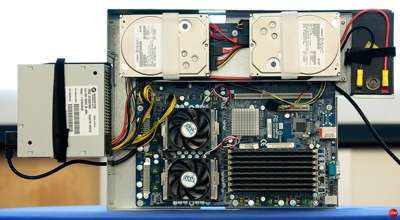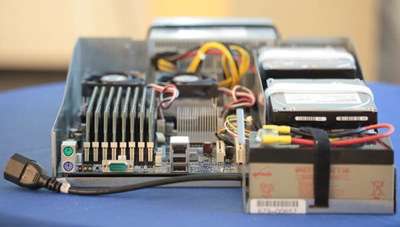Google 数据中心和服务器的一些信息
2009年10月22日 | 标签: architecture, server | 作者:vpsee
Google 工程师 Jeff Dean 在刚过去的 LADIS 2009 Workshop 上做了一个 keynote talk:Designs, Lessons and Advice from Building Large Distributed Systems,并且透露了 Google 正在进行一个叫做 “Spanner” 的计划,设计目标是能扩展到1000万台服务器。Google 按照 Servers -> Racks -> Clusters -> Data centers 这样的顺序把服务器从机柜扩展到多个数据中心。VPSee 最近在部署 SunRay 和虚拟化,需要采购更多的服务器,基本选定就 SUN 了,因为有买一台送一台的优惠,剩下的问题就是每台服务器配置多大的处理器、内存和硬盘能充分发挥服务器的能力,达到最佳性价比,这篇 pdf 提到了每台 Google 服务器的配置,CNET 的这篇报道还提供了 Google 服务器的照片。
Google 服务器:
The Google server was 3.5 inches thick–2U, or 2 rack units, in data center parlance. It had two processors, two hard drives, and eight memory slots mounted on a motherboard built by Gigabyte. Google uses x86 processors from both AMD and Intel.

有意思的是 Google 服务器用到了电池,原因是比 UPS 要便宜的多:
“This is much cheaper than huge centralized UPS,” he said. “Therefore no wasted capacity.”

Server: DRAM: 16GB, 100ns, 20GB/s, Disk: 2TB, 10ms, 200MB/s
Rack (80 servers): DRAM: 1TB, 300us, 100MB/s, Disk: 160TB, 11ms, 100MB/s
Clusters (30+ racks): DRAM: 30TB, 500us, 10MB/s, Disk: 4.80PB, 12ms, 10MB/s
一些经验和数据:
1-5% of your disk drives will die
Servers will crash at least twice (2-4% failure rate)
一些每个人都应该知道的数据:
L1 cache reference 0.5 ns
Branch mispredict 5 ns
L2 cache reference 7 ns
Mutex lock/unlock 25 ns
Main memory reference 100 ns
Compress 1K bytes with Zippy 3,000 ns
Send 2K bytes over 1 Gbps network 20,000 ns
Read 1 MB sequentially from memory 250,000 ns
Round trip within same datacenter 500,000 ns
Disk seek 10,000,000 ns
Read 1 MB sequentially from disk 20,000,000 ns
Send packet CA->Netherlands->CA 150,000,000 ns
一个新 cluster 通常第一年会发生的事情:
~0.5 overheating (power down most machines in <5 mins, ~1-2 days to recover) ~1 PDU failure (~500-1000 machines suddenly disappear, ~6 hours to come back) ~1 rack-move (plenty of warning, ~500-1000 machines powered down, ~6 hours) ~1 network rewiring (rolling ~5% of machines down over 2-day span) ~20 rack failures (40-80 machines instantly disappear, 1-6 hours to get back) ~5 racks go wonky (40-80 machines see 50% packetloss) ~8 network maintenances (4 might cause ~30-minute random connectivity losses) ~12 router reloads (takes out DNS and external vips for a couple minutes) ~3 router failures (have to immediately pull traffic for an hour) ~dozens of minor 30-second blips for dns ~1000 individual machine failures ~thousands of hard drive failures slow disks, bad memory, misconfigured machines, flaky machines, etc.
不知google服务器两个硬盘组了raid不
还是百度疯狂啊。全部换ssd